Recently, Google rolled out a new algorithm update named “Helpful Content Update”.
This will be a game changer for every brand that produces content on its website. The idea behind this update is to crack down on content that’s written for just SEO purposes without readers in mind.
So, what does this mean for content marketers?
If you’ve been creating content merely for SEO, you have to be very afraid. We’ve already started seeing SEO-driven content disappearing from Google’s 1st page. But there’s nothing to worry about if you’ve produced quality, insightful content.
No matter how you look at it, the content marketing game is changing for the better. This is the right time to start doubling down on content that meets users’ needs. This is the time to think about the user before you start pecking that keyboard.
Lucky for you, you’re reading an article that will help you create a content marketing strategy that meets user needs and ranks higher on Google. Continue reading to learn more…
What’s a Content Marketing Strategy?
A content marketing strategy is a plan for how you will create and distribute valuable, relevant, and consistent content to attract and retain your target audience.
Your strategy should align with your business goals and should be based on understanding your audience’s needs and preferences.
It requires understanding your target audience, their needs and pain points, and what kind of content will resonate with them.
Once you have that understanding, you can develop a plan for creating and distributing content to help you achieve your business goals.
And by content, I mean all content types, not just written content like this blog, audio content like podcasts, video content like YouTube videos, and TikTok videos.
This blog will discuss the content marketing strategy and how you can build one for yourself.
And our journey begins with the anatomy of a good content marketing strategy and what makes a good one, so let’s jump right into it.
How to Create a Content Marketing Strategy
Now that we know what a content marketing strategy is and what it has. Let’s jump into how you can create one for your business.
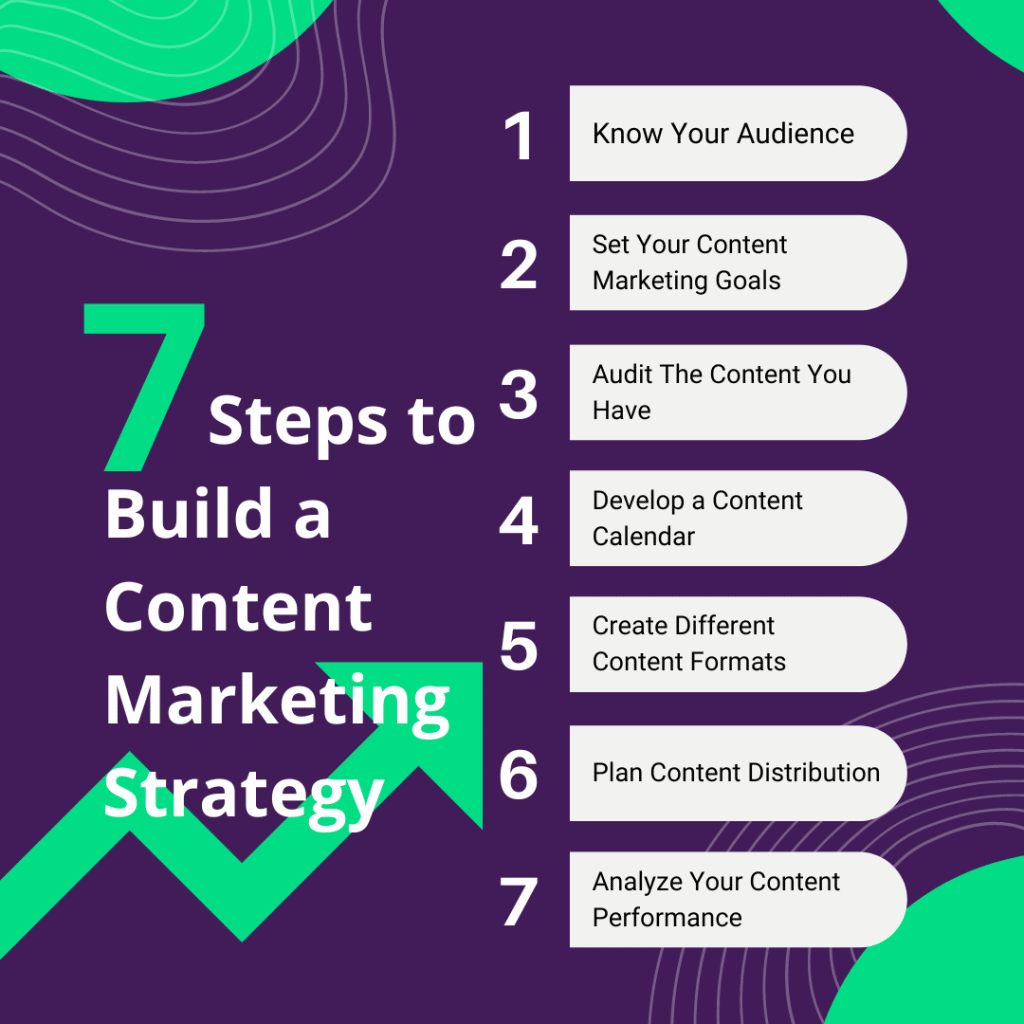
Step 1: Know Your Audience
Do you really know your audience, tone of voice, and language? You must ensure you’ve got these things right from the start.
So what do I suggest so you know your audience very well? Simple, join their conversations and communicate with them.
If you’re looking for what the audience really wants and asks about, then using traditional research methods could be less fruitful.
You need to join the communities where your ICP lives, and let me give you an example of an SEO specialist.
You want to create content that’s worth their time and relates to an issue they’re facing.
Look up the most famous Facebook groups about SEO and join them. Each day try to note down the topics that people ask about.
Do that for a couple of days or weeks and check which topics are most asked about.
Then create high-quality, engaging content for these topics and start answering questions on the group.
These people want answers, and your content gives them the answer they’re looking for, so they’re a warm, ripe audience.
Step 2: Set Your Marketing Goals
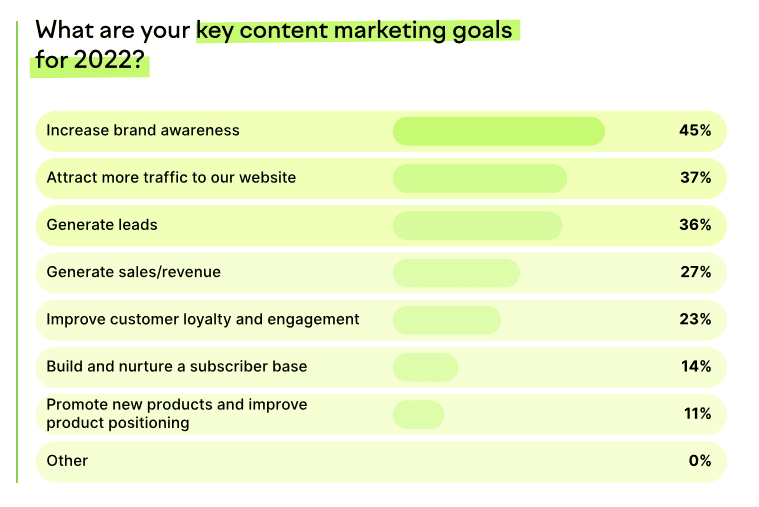
Source: SEMRush’s ‘State Of Content Marketing’ report
According to SEMRush’s ‘State Of Content Marketing’ report, 45% of people use content to fuel their brand awareness, while 37% use it to get more visitors to their website.
Since content is versatile, you can use it to achieve multiple goals simultaneously without an issue because content can work as a funnel for your company.
You can write top-of-the-funnel content to drive more awareness about you and your business. These blogs work as a wide net to catch people who might be interested in your content but not necessarily searching for it at the moment.
An example of that would be this blog you’re reading right now; this is top-of-the-funnel content that we’re writing to drive traffic to our website so more people can know about us.
If you want to read more about setting your objectives, here’s a blog about objective setting that would help you get the most out of your planning.
Audit Your Content
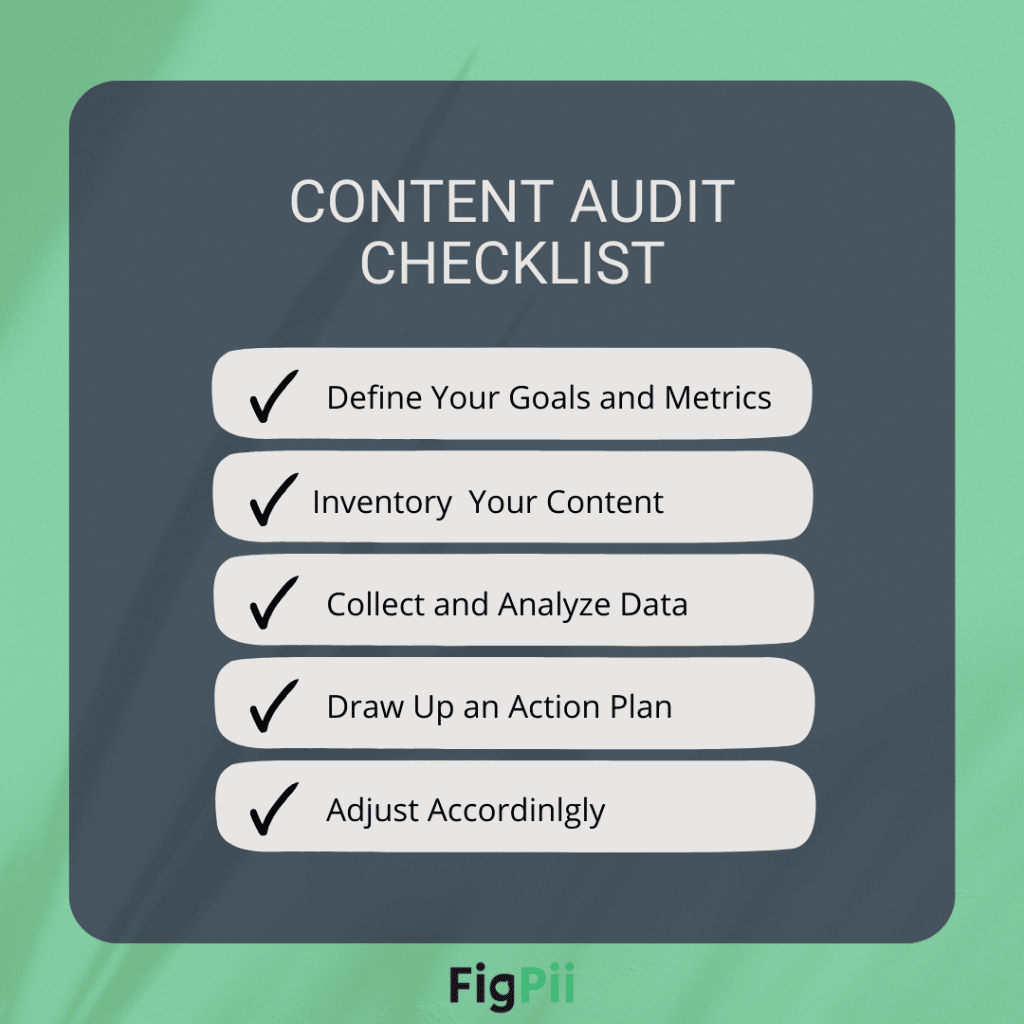
Your content audit should consist of five major steps or phases to ensure that you’re producing content that gets you results.
- Define your goals
The first step is setting a goal that you want to achieve. In a previous example, I told you that one of FigPii’s main goals is to reach 3,000 visitors a month by the end of this quarter.
- Inventory Your Content
Now create an inventory sheet of all your content on your website, from blogs to videos to tutorials.
Here’s a spreadsheet template to help you efficiently inventory without fear of mixing everything up.
- Draw up an action plan
After you’ve made your analysis and everything, start setting up your plan to publish your content.
What do you want to be at the forefront of your content marketing efforts? Which channels drive you the most conversions?
- Adjust accordingly
Now that you have your content plan ready and executing adjust your CMS to any updates that happen based on your most recent audit.
Develop a Content Calendar
Your content creation process should be going according to plan, preferably your editorial plan.
I recommend keeping all your content calendars in the same sheet or tool, so you don’t have to jump around every time you want to double-check your progress according to the plan.
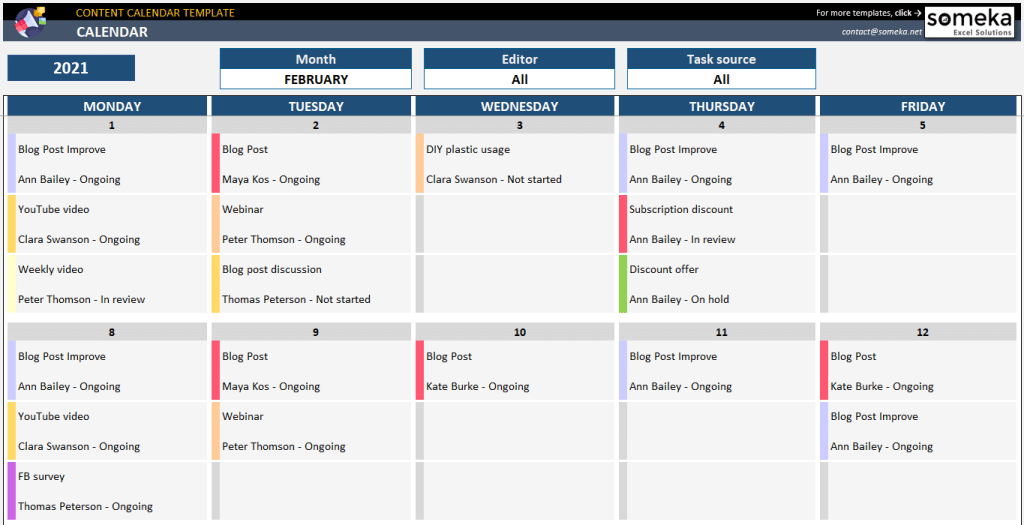
A simple content calendar like this should be sufficient for you; if you want an online calendar, you can check SEMRush, Hootsuite, or many other tools that provide this service.
You can download the content calendar template from here and customize it to your liking to get the most out of your content production plans.
Create Different Content Formats
According to SEMRush’s report, videos have overcome blogs as the best performing type of content in 2022, and it doesn’t come as a surprise because people watch videos all the time.
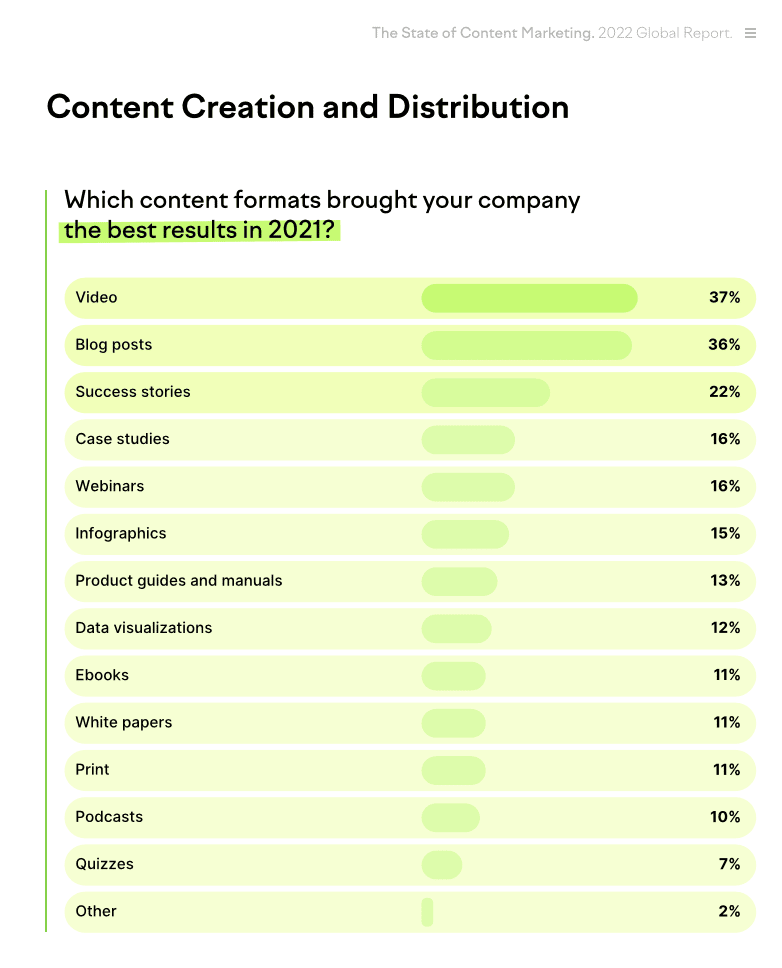
Source: SEMRush’s ‘State Of Content Marketing’ report
As you can see, content isn’t just a blog; some other forms of content started gaining popularity more than blogs themselves.
But blogs still have a massive impact because of SEO and people who love to read and skim content, so you must utilize various content types when building your content library.
Take Ahrefs, for example, they have such an excellent YouTube channel that they produce content regularly on, but they also have one of the best blogs for SEO.
They planned this all along; repurposing content and creating new content formats out of existing content is one of the most clever things you can do as a content marketer.
You should see where your content can be the most impactful and go for it.
If your research shows a gap in video content, you should create content for YouTube and LinkedIn.
If no one covered the content you’re talking about when it comes to blog, then start a blog.
So which content type you should go with depends on what your research showed you.
Plan Content Distribution
“It’s not the best content that wins. It’s the best promoted content that wins.” ~ Andy Crestodina
If no one sees your content, what good does it do creating it in the first place? You need to work on distribution from the get-go.
You need to bake in content distribution within your content plan, see what channels work the best, and list them here. Let me give you an example.
- Tl;dr
We produce a lot of articles here at FigPii, and we want to share them on LinkedIn, but if we put a link in our post, that would kill its reach.
So we compressed the article into 500 words and posted it as a LinkedIn article and a Medium article with a link at the bottom of the article linking to the original one.
Using this strategy helps us get into more feeds, and our content gets read by more people on different platforms.
- Forums
Other good channels you should be utilizing is for sure IndieHacker and Hackernews.
As a marketer who looks to read content written for marketers, I check these websites weekly.
Reddit could be a very effective channel for distributing your content. Alas, you need to invest time in building up your place in a community before posting any blogs.
Reddit can make or break your image on the platform, so make sure you know your platform and what’s the best way to get them on your side.
Another similar channel, Facebook groups, follow a similar mantra to Reddit because most groups won’t let you spam links without context.
Another good channel? Email newsletters. I see a lot of people missing this highly effective distribution channel.
Users might not visit your blog every day, but everyone checks their email, admittedly they probably won’t see every email you send, but it builds a relationship with your customers.
Analyze Your Content Performance
To improve your content performance, it is crucial to analyze how well your content is performing.
This can be done by looking at various metrics, such as engagement, reach, and conversions. By understanding how your content performs, you can make changes to improve its effectiveness.
As I explained, you can do that over on Google Analytics by drilling down your content and seeing which ones get the most views.
You can do the same on social media platforms to see which posts get more views, impressions, and engagement.
Different platforms will have different KPIs and metrics you want to follow. I recommend keeping everything in one dashboard using something like Google Data Studio.
Let me give you an example of how we track our content performance at FigPii.
For this, we’ll use Google Analytics, FigPii’s heatmaps, and Ahrefs.
From the side menu in GA, head to Behavior, then site content, then all pages.

That will show you all the pages on your website and how they are performing overall in terms of
- Pageviews
- Bounce rate
- Avg time on page
- Exit rate
What you want to look at is what blogs are doing well for you according to GA regarding page views and avg time on page.
This will give you a good idea of what content performs well on your blog. Make a list of the top 10 performing blogs or pieces of content.
Then head to FigPii and launch heatmap analysis for these blogs that are doing well. What you want to check for how far people scroll and how much time they spend on it.
This will take some time, so let it run for a while before drawing any conclusions, and in the meantime, head over to Ahrefs.
On their dashboard, take the URLs of the blogs that are performing the best and see what keywords they rank for and which position they are in.
You’re all good to go if they rank near the top 3. Keep tracking them and see how they do long-term.
What if they don’t rank near the top 3? Simply run them through a tool like Surfer or Neuronwriter and optimize them for the terms they rank for.

